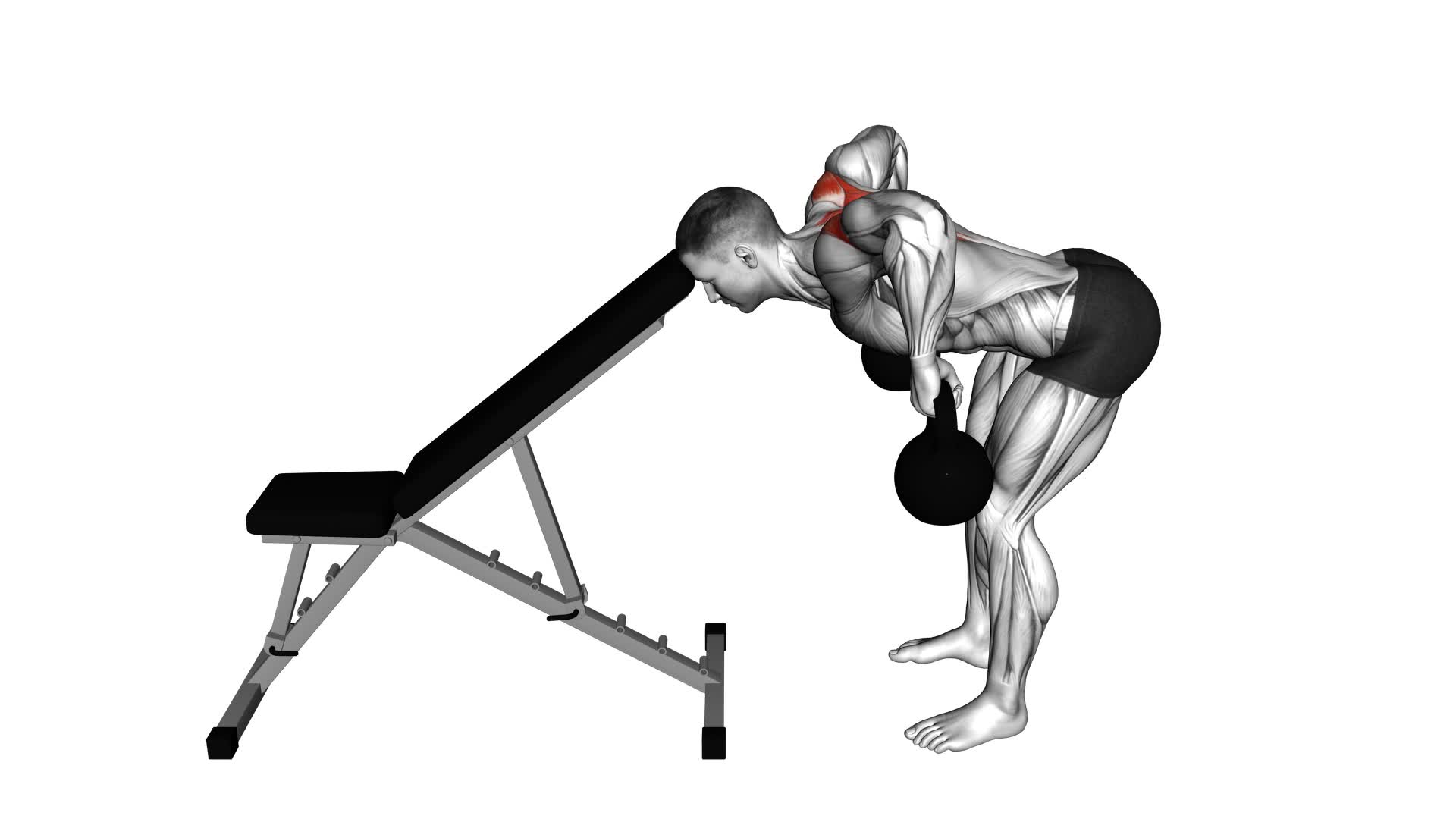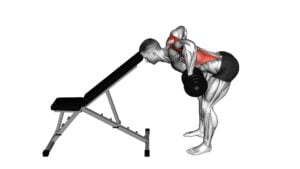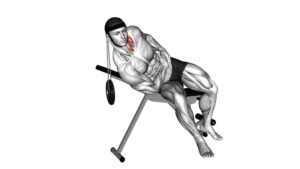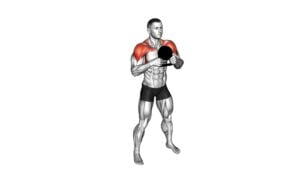Kettlebell Head Supported Row – Video Exercise Guide & Tips

Are you looking for a challenging workout that targets your back muscles? Look no further than the Kettlebell Head Supported Row!
Watch This Exercise Video
In this video exercise guide, we'll show you the proper form and technique to get the most out of this exercise. We'll also share common mistakes to avoid and variations to keep you challenged.
Maximize your results and take your fitness to the next level with the Kettlebell Head Supported Row.
Let's get started!
Key Takeaways
- The Kettlebell Head Supported Row is a highly beneficial exercise for increasing back strength and stability.
- This exercise targets the latissimus dorsi, rhomboids, and trapezius muscles, helping to strengthen and stabilize the upper and lower back.
- Using proper form and technique, such as maintaining stability and engaging the back muscles, is essential for maximizing the benefits of this exercise.
- Gradually increasing weight or difficulty and maintaining consistency with proper form are key factors in achieving optimal results with the Kettlebell Head Supported Row.
Benefits of the Kettlebell Head Supported Row
You will experience increased back strength and stability with the Kettlebell Head Supported Row. This exercise is highly beneficial for injury prevention and muscle activation.
By performing the Kettlebell Head Supported Row, you engage your back muscles, specifically the latissimus dorsi, rhomboids, and trapezius, which are responsible for pulling movements and maintaining proper posture. This exercise targets both the upper and lower back, helping to strengthen and stabilize the entire back region.
The Kettlebell Head Supported Row also promotes injury prevention by improving the stability of your spine. When you support your head on a bench or exercise ball, it helps to maintain a neutral spine position throughout the exercise. This reduces the risk of straining or injuring your back during the movement. Additionally, the controlled nature of this exercise allows you to focus on proper form, ensuring that you're engaging the correct muscles and avoiding any unnecessary strain on your back.
Furthermore, the Kettlebell Head Supported Row activates multiple muscles simultaneously, making it a time-efficient exercise for building back strength. By incorporating this exercise into your routine, you can improve your overall back strength, stability, and posture while minimizing the risk of injury.
Equipment Needed for the Exercise
To perform the Kettlebell Head Supported Row, you'll need a bench or an exercise ball for support. These pieces of equipment are essential for maintaining proper form and stability during the exercise. The bench provides a stable surface to rest your head on, while the exercise ball offers an unstable surface that engages your core muscles to a greater extent.
Modifications and adaptations can be made based on the equipment available to you. If you don't have a bench, you can use a sturdy chair or even the edge of a bed as a substitute. However, make sure that whatever alternative you choose provides adequate support for your head.
Similarly, if you don't have an exercise ball, you can perform the exercise without it. However, using an exercise ball adds an extra challenge to the exercise by engaging your core muscles. If you're a beginner or have difficulty with balance, it's recommended to start without the exercise ball and gradually progress to using it as you gain strength and stability.
Now that you understand the equipment needed for the Kettlebell Head Supported Row, let's move on to the next section and discuss the proper form and technique for this exercise.
Proper Form and Technique for the Kettlebell Head Supported Row
To perform the Kettlebell Head Supported Row with proper form and technique, focus on engaging your back muscles and maintaining a stable position throughout the exercise.
Start by lying face down on an incline bench, with your head supported. Grab a kettlebell with an overhand grip and let your arms hang straight down. Keep your back straight and your core engaged throughout the movement.
To initiate the row, squeeze your shoulder blades together and pull the kettlebell towards your chest, leading with your elbows. Keep your elbows close to your body as you perform the row. Pause for a moment at the top of the movement, squeezing your back muscles. Then, slowly lower the kettlebell back to the starting position, maintaining control and tension in your back muscles.
There are variations and progressions you can incorporate into the Kettlebell Head Supported Row to challenge yourself further. You can increase the weight of the kettlebell as you get stronger, or perform the exercise with one arm at a time to target each side independently. Additionally, you can perform the exercise on a flat bench instead of an incline bench to change the angle of the movement.
Common Mistakes to Avoid During the Exercise
Avoiding common mistakes is crucial when performing the Kettlebell Head Supported Row exercise. By being aware of these errors, you can ensure that you're maximizing the benefits of the exercise while minimizing the risk of injuries.
One common mistake to avoid is using too much weight. It's important to choose a kettlebell that you can comfortably handle, as using a weight that's too heavy can strain your muscles and increase the risk of injury.
Another mistake to avoid is rounding your back during the exercise. This can put unnecessary stress on your spine and lead to poor posture. To improve your posture, focus on keeping your back straight and your shoulders pulled back throughout the movement.
Additionally, make sure to engage your core muscles and maintain a stable position throughout the exercise. By avoiding these mistakes and practicing proper form, you can safely perform the Kettlebell Head Supported Row exercise and reap the benefits of improved posture and strength.
Variations and Progressions to Challenge Yourself
Challenge yourself with different variations and progressions of the Kettlebell Head Supported Row exercise. By incorporating variations into your routine, you can target different muscle groups and keep your workouts interesting and challenging.
One variation you can try is the single-arm kettlebell row, where you perform the exercise with one arm at a time. This variation increases the demand on your core and stabilizer muscles.
Another variation is the staggered stance kettlebell row, where you stagger your feet instead of having them parallel. This variation adds an element of instability, forcing your core and leg muscles to work harder to maintain balance.
If you're looking to progress the exercise, you can increase the weight of the kettlebell or perform the exercise on an unstable surface, such as a Bosu ball or a balance board. These progressions further challenge your stability and strength.
By incorporating these variations and progressions into your routine, you can continue to challenge yourself and see improvements in strength and muscle development.
Now, let's move on to some tips to maximize your results with the kettlebell head supported row.
Tips to Maximize Your Results With the Kettlebell Head Supported Row
How can you ensure maximum results from the Kettlebell Head Supported Row exercise? To make the most of this exercise and maximize your results, follow these tips:
- Perfect your kettlebell row technique: Proper form is essential for targeting the right muscles and preventing injuries. Maintain a neutral spine, engage your core, and keep your shoulders relaxed. Focus on pulling the kettlebell towards your chest using your back muscles, rather than relying on your arms.
- Increase the resistance gradually: Start with a weight that challenges you but allows you to maintain proper form. As you become stronger and more comfortable with the exercise, gradually increase the weight of the kettlebell to continue challenging your muscles and stimulating growth.
- Take advantage of the benefits of rowing: The Kettlebell Head Supported Row is an excellent exercise for strengthening your back, shoulders, and core muscles. It also helps improve your posture and stability. To maximize your results, incorporate this exercise into a well-rounded strength training routine that includes exercises targeting other muscle groups as well.
Frequently Asked Questions
How Many Sets and Repetitions Should I Do for the Kettlebell Head Supported Row?
To determine the number of sets and repetitions for the kettlebell head supported row, start with your current fitness level and gradually increase the intensity.
Focus on maintaining proper form and technique to avoid common mistakes.
As you progress, you can add more sets and repetitions to challenge yourself.
Remember to listen to your body and adjust accordingly.
Can I Perform the Kettlebell Head Supported Row With a Dumbbell Instead of a Kettlebell?
Yes, you can perform the dumbbell head supported row as a variation of the kettlebell head supported row. By using a dumbbell instead of a kettlebell, you can still effectively target your back muscles and improve your strength.
Just make sure to maintain proper form and alignment throughout the exercise.
The dumbbell head supported row is a great alternative if you don't have access to a kettlebell or want to switch up your routine.
What Muscles Does the Kettlebell Head Supported Row Target?
The kettlebell head supported row targets multiple muscles in your upper body. It primarily works your back muscles, including the latissimus dorsi and rhomboids, helping to improve your posture and upper body strength.
Additionally, it engages your biceps and shoulders, providing a comprehensive upper body workout.
This exercise also has variations that can target different muscle groups, allowing you to customize your workout to meet your specific goals and preferences.
Is the Kettlebell Head Supported Row Suitable for Beginners?
Yes, the kettlebell head supported row is suitable for beginners. It's important to focus on proper form and technique when performing this exercise.
Start with a lighter weight and gradually increase as you build strength. Keep your back straight, engage your core, and squeeze your shoulder blades together as you row the kettlebell towards your chest.
This exercise targets your back muscles and can help improve posture and upper body strength.
Can I Substitute the Kettlebell Head Supported Row With Other Exercises for Similar Benefits?
Yes, you can substitute the kettlebell head supported row with other exercises to achieve similar benefits for upper body strength.
Some alternatives to the kettlebell head supported row include dumbbell rows, barbell rows, and cable rows.
These exercises target the same muscles and help improve your back, shoulders, and arm strength.
Incorporating these exercises into your workout routine can provide a variety of movements and increase the effectiveness of your training.
Conclusion
The kettlebell head supported row is a beneficial exercise that targets the back and shoulders while also engaging the core. It requires minimal equipment and can be easily modified to suit different fitness levels.
By maintaining proper form and avoiding common mistakes, you can maximize your results and challenge yourself with variations and progressions.
Incorporating the kettlebell head supported row into your workout routine can help improve strength and posture.

Author
Years ago, the spark of my life’s passion ignited in my mind the moment I stepped into the local gym for the first time. The inaugural bead of perspiration, the initial endeavor, the very first surge of endorphins, and a sense of pride that washed over me post-workout marked the beginning of my deep-seated interest in strength sports, fitness, and sports nutrition. This very curiosity blossomed rapidly into a profound fascination, propelling me to earn a Master’s degree in Physical Education from the Academy of Physical Education in Krakow, followed by a Sports Manager diploma from the Jagiellonian University. My journey of growth led me to gain more specialized qualifications, such as being a certified personal trainer with a focus on sports dietetics, a lifeguard, and an instructor for wellness and corrective gymnastics. Theoretical knowledge paired seamlessly with practical experience, reinforcing my belief that the transformation of individuals under my guidance was also a reflection of my personal growth. This belief holds true even today. Each day, I strive to push the boundaries and explore new realms. These realms gently elevate me to greater heights. The unique combination of passion for my field and the continuous quest for growth fuels my drive to break new ground.







